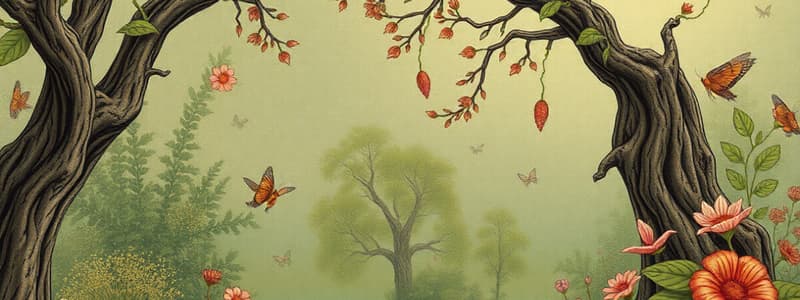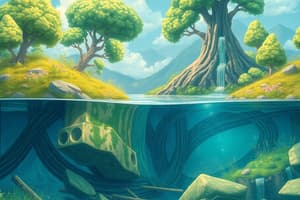Podcast
Questions and Answers
Which of the following best describes the flow of energy in an ecosystem?
Which of the following best describes the flow of energy in an ecosystem?
- Cyclical, with energy returning to the sun.
- Unidirectional, from the sun to producers to consumers to decomposers. (correct)
- Bidirectional, with energy flowing between producers and consumers only.
- Random, with energy distributed evenly among all organisms.
What is the primary role of decomposers in nutrient cycling within an ecosystem?
What is the primary role of decomposers in nutrient cycling within an ecosystem?
- Converting solar energy into chemical energy.
- Absorbing nutrients directly from the atmosphere.
- Consuming primary producers to obtain energy.
- Breaking down dead organic matter and releasing nutrients back into the environment. (correct)
How does a food web differ from a food chain?
How does a food web differ from a food chain?
- A food web shows the flow of energy, while a food chain shows the cycling of nutrients.
- A food web is linear, while a food chain is a complex network.
- A food web represents multiple interconnected food chains, while a food chain is a single, linear pathway. (correct)
- A food web only includes producers, while a food chain includes producers and consumers.
What is a trophic cascade, and what is an example of it?
What is a trophic cascade, and what is an example of it?
What defines a keystone species?
What defines a keystone species?
How can rising global temperatures due to climate change affect species distributions?
How can rising global temperatures due to climate change affect species distributions?
What is ocean acidification, and what causes it?
What is ocean acidification, and what causes it?
How do extreme weather events, such as hurricanes and heatwaves, impact ecosystems?
How do extreme weather events, such as hurricanes and heatwaves, impact ecosystems?
What does the term 'biodiversity' encompass?
What does the term 'biodiversity' encompass?
What is the main goal of in-situ conservation?
What is the main goal of in-situ conservation?
How does deforestation contribute to habitat destruction?
How does deforestation contribute to habitat destruction?
What is habitat fragmentation, and what are its potential consequences?
What is habitat fragmentation, and what are its potential consequences?
How can invasive species contribute to habitat degradation?
How can invasive species contribute to habitat degradation?
Which of the following is an example of ex-situ conservation?
Which of the following is an example of ex-situ conservation?
What is the role of primary producers in an ecosystem?
What is the role of primary producers in an ecosystem?
How can changes in precipitation patterns due to climate change impact ecosystems?
How can changes in precipitation patterns due to climate change impact ecosystems?
What is the purpose of species recovery plans in biodiversity conservation?
What is the purpose of species recovery plans in biodiversity conservation?
How does urbanization lead to habitat destruction?
How does urbanization lead to habitat destruction?
What is the significance of the Convention on Biological Diversity?
What is the significance of the Convention on Biological Diversity?
What does ecosystem stability refer to?
What does ecosystem stability refer to?
Flashcards
Ecology
Ecology
The study of interactions between organisms and their environment, including biotic and abiotic factors.
Ecosystem
Ecosystem
A community of living organisms interacting with their non-living environment, involving energy flow and nutrient cycling.
Ecosystem stability
Ecosystem stability
The ability of an ecosystem to resist changes or recover quickly after a disturbance.
Trophic level
Trophic level
Signup and view all the flashcards
Food chain
Food chain
Signup and view all the flashcards
Food web
Food web
Signup and view all the flashcards
Trophic cascade
Trophic cascade
Signup and view all the flashcards
Keystone species
Keystone species
Signup and view all the flashcards
Climate change
Climate change
Signup and view all the flashcards
Biodiversity
Biodiversity
Signup and view all the flashcards
In-situ conservation
In-situ conservation
Signup and view all the flashcards
Ex-situ conservation
Ex-situ conservation
Signup and view all the flashcards
Habitat destruction
Habitat destruction
Signup and view all the flashcards
Deforestation
Deforestation
Signup and view all the flashcards
Habitat fragmentation
Habitat fragmentation
Signup and view all the flashcards
Invasive species
Invasive species
Signup and view all the flashcards
Study Notes
- Ecology is the study of interactions between organisms and their environment.
- It examines how organisms interact with each other and their physical surroundings, including both biotic (living) and abiotic (non-living) factors.
- Key areas within ecology include population ecology, community ecology, and ecosystem ecology.
Ecosystem Dynamics
- An ecosystem is a community of living organisms (biotic components) interacting with their non-living environment (abiotic components).
- Ecosystem dynamics involve the flow of energy and cycling of nutrients through the system.
- Energy flow is typically unidirectional, starting with the sun, moving to producers (plants), then to consumers (herbivores and carnivores), and finally to decomposers.
- Nutrient cycling involves the movement of essential elements (e.g., carbon, nitrogen, phosphorus) through biotic and abiotic components of the ecosystem.
- Key processes in nutrient cycles include decomposition, assimilation, and mineralization.
- Ecosystems can vary in size and complexity, ranging from a small pond to a vast forest.
- Ecosystem stability refers to the ability of an ecosystem to resist changes or recover quickly after a disturbance.
- Trophic levels describe the position of an organism in a food chain or food web.
- Primary producers (autotrophs) form the base of the food chain, followed by primary consumers (herbivores), secondary consumers (carnivores), and tertiary consumers (top predators).
Food Chains and Webs
- A food chain is a linear sequence of organisms through which nutrients and energy pass as one organism eats another.
- It illustrates a simple pathway of energy flow from producers to consumers.
- A food web is a complex network of interconnected food chains within an ecosystem.
- It represents the multiple feeding relationships among various organisms.
- Food webs provide a more realistic depiction of energy flow and trophic interactions in an ecosystem.
- Trophic cascades occur when changes at one trophic level have cascading effects on other levels in the food web.
- The removal of a top predator can lead to an increase in herbivore populations, which can then reduce plant biomass for example.
- Keystone species play a critical role in maintaining the structure and function of an ecosystem.
- Their impact is disproportionately large relative to their abundance.
- Removal of a keystone species can lead to significant changes in the ecosystem, potentially causing it to collapse.
Climate Change Impact
- Climate change refers to long-term shifts in temperature and weather patterns, largely driven by human activities that increase greenhouse gas emissions.
- Rising global temperatures can alter species distributions, phenology (timing of biological events), and ecosystem processes.
- Changes in precipitation patterns can lead to droughts or floods, impacting plant growth and water availability for organisms.
- Ocean acidification, caused by increased absorption of carbon dioxide by the oceans, threatens marine ecosystems, particularly coral reefs and shellfish.
- Sea-level rise can inundate coastal habitats, leading to habitat loss and displacement of coastal species.
- Extreme weather events, such as hurricanes, heatwaves, and wildfires, are becoming more frequent and intense, causing widespread damage to ecosystems.
- Species extinction rates are accelerating due to climate change, with many species unable to adapt quickly enough to changing environmental conditions.
- Climate change can disrupt species interactions, leading to mismatches in timing between predators and prey, or between plants and pollinators.
- Shifts in species distributions can lead to the formation of novel ecosystems, with unpredictable consequences.
Biodiversity Conservation
- Biodiversity refers to the variety of life on Earth at all levels, from genes to ecosystems.
- It includes species diversity (number and abundance of different species), genetic diversity (variation within species), and ecosystem diversity (variety of ecosystems).
- Biodiversity is essential for ecosystem functioning, providing ecosystem services such as pollination, water purification, and climate regulation.
- Conservation biology is a scientific discipline that focuses on protecting and managing biodiversity.
- In-situ conservation involves protecting species in their natural habitats through the establishment of protected areas, such as national parks and reserves.
- Ex-situ conservation involves protecting species outside their natural habitats, such as in zoos, botanical gardens, and seed banks.
- Habitat restoration aims to restore degraded ecosystems to a more natural and functional state.
- Species recovery plans are developed to help recover endangered or threatened species populations.
- Conservation strategies often involve managing human activities to reduce their impact on biodiversity, such as regulating hunting, fishing, and logging.
- International agreements and conventions, such as the Convention on Biological Diversity, play a critical role in promoting biodiversity conservation at a global scale.
Habitat Destruction
- Habitat destruction is the process by which natural habitats are rendered functionally unable to support the species present.
- Deforestation, or the clearing of forests for other land uses, is a major driver of habitat destruction, leading to loss of biodiversity and carbon sequestration.
- Agricultural expansion converts natural habitats into farmland, reducing habitat availability for native species.
- Urbanization results in the conversion of natural habitats into built environments, fragmenting habitats and isolating populations.
- Mining activities can destroy habitats through direct removal of vegetation and soil, as well as through pollution and habitat fragmentation.
- Pollution from industrial activities, agriculture, and urban runoff can degrade habitats, making them unsuitable for many species.
- Habitat fragmentation occurs when large, continuous habitats are broken up into smaller, isolated patches.
- This can lead to reduced gene flow, increased risk of extinction for small populations, and altered species interactions.
- Invasive species can outcompete native species for resources, alter habitat structure, and introduce diseases, contributing to habitat degradation.
- Climate change can also exacerbate habitat destruction by altering environmental conditions and increasing the frequency of extreme weather events.
- Protecting and restoring habitats is crucial for conserving biodiversity and maintaining ecosystem services.
Studying That Suits You
Use AI to generate personalized quizzes and flashcards to suit your learning preferences.




